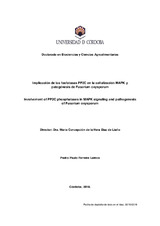Involvement of PP2C phosphatases in MAPK signaling and pathogenesis of Fusarium oxysporum
Implicación de las fosfatasas PP2C en la señalización MAPK y patogénesis de Fusarium oxysporum
Autor
Ferreira Lemos, Pedro Paulo
Director/es
Hera Díaz de Liaño, María Concepción de laEditor
Universidad de Córdoba, UCOPressFecha
2019Materia
Pathogenic fungusFusarium oxysporum
Phosphorylation
Phosphatases
2C protein phosphatases
Mitogen activated protein kinase
Pathogenesis
Genetic
METS:
Mostrar el registro METSPREMIS:
Mostrar el registro PREMISMetadatos
Mostrar el registro completo del ítemResumen
La fosforilación reversible de proteínas es crucial en la transducción de señales celulares
en dianas de respuesta al estrés en eucariotas. Fusarium oxysporum es un hongo fitopatógeno
y saprofito que habita el suelo y que logra adaptarse a una amplia gama de nichos ecológicos y
condiciones ambientales. En F. oxysporum se ha demostrado que tres cascadas de proteínas
quinasas activadas por mitógeno (MAPK) establecen la respuesta del hongo a variaciones
ambientales tales como alta temperatura, daños en la pared celular, estrés oxidativo o
hiperosmótico. Sin embargo, las proteínas fosfatasas que regulan los niveles de fosforilación en
diferentes vías MAPK son desconocidas. En este estudio, nos hemos centrado en elucidar el
papel de las proteínas fosfatasas tipo 2C (PP2C) en la señalización MAPK y en la patogénesis
de F. oxysporum f. sp. lycopersici.
En el presente estudio se identificaron siete fosfatasas PP2C en F. oxysporum, Ptc1,
Ptc3, Ptc5, Ptc5R, Ptc6, Ptc7 y Ptc7R. El análisis de la expresión génica reveló que los genes
PP2C de F. oxysporum están regulados de forma orquestada en respuesta a estreses que
activan rutas MAPK. Los ensayos fenotípicos revelaron que mutantes PP2C presentan
sensibilidad a agentes perturbadores de la pared celular en comparación con la estirpe de tipo
salvaje.
El nivel de fosforilación de la ruta MAPK Mpk1 demostró que Ptc1, Ptc5 y Ptc7 tienen
papeles en el mantenimiento la integridad celular. Además, fue demostrado que Ptc1 regula la
fosforilación de la MAPK Hog1 en respuesta de alta osmolaridad y glicerol (HOG), y se encontró
que Ptc5 es un regulador negativo de la fosforilación de ruta MAPK Fmk1 de crecimiento invasivo.
El mutante Δptc1 ha mostrado adicional tolerancia a compuestos de estrés osmótico, incremento
en la expresión de los genes inducidos por dicho estrés y vacuolas fragmentadas incluso en
ausencia de agentes de estres osmótico, lo que apoya la contribución de Ptc1 en la vía de
señalización HOG. Dos cepas mutantes, Δptc5 y Δptc5R mostraron virulencia reducida en el
huésped tomate. En conjunto, los resultados presentados indican por primera vez el papel de
fosfatasas PP2C en la regulación de vías de señalización MAPK en F. oxysporum. Reversible protein phosphorylation is crucial for cell signal transduction in stress
response of eukaryotes. Fusarium oxysporum is a soil-borne plant pathogenic fungus that can
adapt to a wide range of ecological niches and environmental conditions. Three mitogen activated
protein kinase (MAPK) cascades have been shown to orchestrate the response of the fungus to
external insults such as high temperature, insults on cell wall, oxidative or hyperosmotic stress in
F. oxysporum. However, the protein phosphatases that fine-tune phosphorylation levels of
different MAPKs in this fungus are unknown. In this study, we have focused on elucidating the
role of type 2C protein phosphatases (PP2C) on MAPK cascade signaling pathways and
pathogenesis of F. oxysporum f. sp. lycopersici.
There were identified seven PP2C phosphatases in the genome of F. oxysporum, Ptc1,
Ptc3, Ptc5, Ptc5R, Ptc6, Ptc7 and Ptc7R. Gene expression analysis revealed that under stresses
that activate MAPK signaling, F. oxysporum PP2C genes are regulated in orchestrated-like
fashion. Phenotypical assays revealed that PP2C disruptant mutants are more sensitive to cell
wall damaging agents in comparison to the wild type strain, suggesting roles on the cell wall
integrity pathway.
MAPK immunoblot analysis demonstrated that Ptc1, Ptc5 and Ptc7 have roles in
regulating the cell wall integrity (CWI) MAPK Mpk1. Moreover, Ptc1 was shown to regulates
phosphorylation of the high osmolarity glycerol response (HOG) MAPK Hog1, and Ptc5 was found
to be a negative regulator of the invasive growth pathway by regulating the phosphorylation level
of the MAPK Fmk1. The Δptc1 mutant have shown increased tolerance to osmotic stress
compounds, higher expression of genes induced by osmotic stress and presented fragmented
vacuoles even in absence of the osmotic stressor, supporting the involvement of Ptc1 in the
negative regulation of the HOG pathway. Two mutant strains, Δptc5 and Δptc5R, showed reduced
virulence on tomato host. Overall, the presented results are the first report of PP2C phosphatases
regulating MAPK signaling pathways in F. oxysporum.

